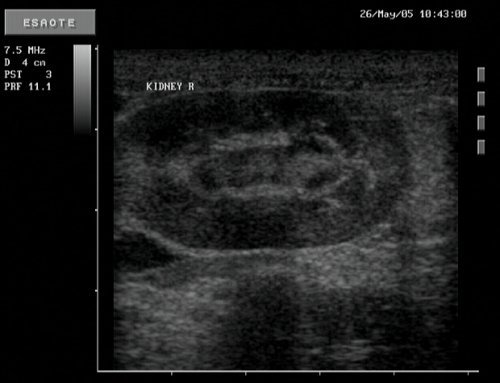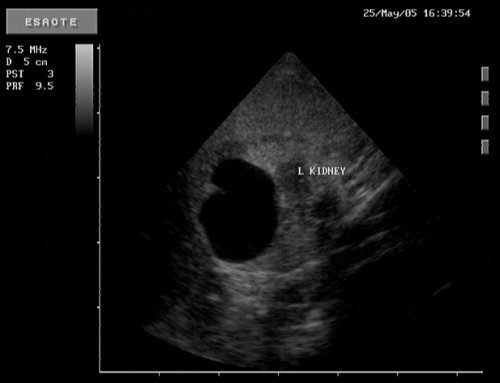Polycystic Kidney Disease (PKD) in Persians and other breeds
[Translated by Jochgem van der Heijden, Ashamta cattery.]
By Dr. Ingrid Putcuyps, veterinarian. 2005.
(Reprinted with permission.)
What is Polycystic Kidney Disease – PKD?
PKD is a hereditary kidney disorder, which implicates that there are already cysts present at birth and usually in both kidneys. These cysts are cavities filled with fluids that originate from normal kidney tissue. In kittens these cavities are in the majority of cases very small (1 to 2 mm). As the animal matures these cavities will become larger (even larger than 2 cm) In one kidney there can be as many as 20 to 200 cysts present.
PKD is also a well known kidney disorder in humans which affects over 5 million people worldwide.
Breeds who carry PKD
The Persian is the most affected breed. Since this breed is and has been the most used breed for outcrossing, we are seeing PKD cases in other breeds as well. The breeds who have been outcrossed with Persians are: the Exotic Shorthair, the Selkirk Rex, the British Shorthair, The Scottish Fold, the Birman, the Ragdoll, the American Shorthair, the Devon Rex and the Maine Coon. In the past Persians were also used in the Norwegian Forest cat, the Sphynx, the Oriental Shorthair, the Cornish Rex, the Abyssinian, the Somali, the Manx and the Burmese, that is why we also see PKD in these breeds.
Symptoms of PKD
Whether a cat becomes ill of PKD or not depends on the size and number of cysts in both kidneys. A cat will display kidney failure (kidney insufficiency) when the cysts occupy too much room in the kidney, and normal kidney tissue is forced out. When there is too little normal kidney tissue left, the kidneys will not be able to function normally and the cat will fall ill. The first symptoms of disease usually occur between the age of 3 and 10 years, but sometimes it is seen at a much younger age.
In the beginning the symptoms are very vague. A cat will drink and urinate more than usual, appetite will become less and the coat will seem less shiny than before. When kidney insufficiency progresses, the animal will start to eat less, will lose weight with possibly also vomiting. Sometimes there is blood present in the urine and extremely bad breath can also be noticed. Once kidney failure has occurred, it is incurable. With an adapted treatment these animals can still reach a high age (see below).
It is important to know that not all cats with PKD will develop kidney failure. Animals with very little or very small cysts will probably never show any signs of PKD.
Treatment of PKD
Until now there is no means available to prevent the development of PKD or to stop the growth of cysts. As a preventative measure the only option would be to remove PKD positive breeding animals from a breeding program. A treatment should only be considered when a cat displays symptoms of kidney failure. Dehydrated and/or vomiting animals should be put on IV for a couple of days. Once the cat is stable, a special kidney diet is the most important treatment. Such a prescription diet contains a lower percentage of protein and less phosphorus than normal cat food. In advanced patients the vet can decide to give additional medication like cardialgia inhibitors, calcium supplements and antibiotics when necessary. Motivated owners can administer hypodermic fluids by themselves at home.
Diagnosis of PKD
Recently the gene responsible for PKD in cats has been isolated by researchers in the US. A commercial test, which is said to be very reliable, is now available. Whether or not a cat is positive for PKD can be determined through a saliva or blood sample. At this moment the test is only developed for Persians and Exotics. A DNA test like this will not give any information about the size or number of cysts, and the DNA test is especially usuful for very young animals because they might have such small cysts that they can not be detected in the ultrasound, or for animals with a doubtful ultrasound testresult (for example an animal with only one cyst in one kidney).
Ultrasound still is a quick and convenient way to diagnose PKD in adult animals. Most animals do not have to be sedated.
Either the cat is put on her back and a rectangle is shaved around the area of the umbilicus giving the vet the opportunity to look at both kidneys. Another method is to look at the kidneys by shaving small rectangles on both flanks of the cat. The first method is better for show animals because the shaved parts are less eye catching. Some cats have a very thin coat of hair so they can be tested without shaving. The fur of these cats is moisturized with alcohol to get rid of air between the hairs. It is important to have the ultrasound done by a veterinary who is familiar with this kind of examinations and who has the right equipment (7,5 - 10 MHz Transducer).
 Ultrasound of a normal kidney |
 Kidney with a cyst |
To verify if there is already kidney insufficiency present in a cat, a blood test and urine test should be performed. Changes will only be seen when 2/3 of the normal kidney tissue is affected. A blood test will show us the levels of red blood cells (too low), ureum, creatine and phosphorus. The last three substances will be above normal levels if the kidney is not functioning normally. The urine test will show these concentrations (too low in badly functioning kidneys) and if there are no signs of urinary tract infection or protein loss through the kidneys.
Inheritance of PKD
A cat has 38 chromosomes, each paired to make 19 pairs. There are two of each chromosome present in a cat (one from each parent). These chromosomes contain genes. A gene is responsible for a certain characteristic like hair colour or a normal developed kidney and is also present in duplicate. At a certain moment something can go wrong with the gene, causing an abnormality within the body (e.g. the formation of cysts in the kidney). When this happens we are talking about a mutation. This mutation can be passed on to the kittens.
PKD is inherited in an autosomal dominant way. "Autosomal" means that the abnormality is not fixed on the chromosomes which determine gender. The gender of the cat is of no importance, both males and females can be affected by the disorder. "Dominant" means that if a kitten has inherited the abnormal gene from one of its parents, it will develop the disease. With a recessive inheritated disorder both father and mother have to pass down the abnormality to show the disease.
The inheritance of a disease also depends on the fact if the parents are homozygous or heterozygous or free of PKD. Like I said before each gene has to be present in duplicate. One gene comes from the mother and one gene comes from the father. Homozygous for PKD means the kitten gets two abnormal genes, one from each parent. There is a lot of doubt if these kittens exist. Probably they die before birth or shortly thereafter. Heterozygous means that the kitten gets one normal gene and one PKD gene. Such animals can either pass the normal gene or the PKD gene on to their offspring. A PKD negative kitten inherits two normal genes and will not pass on PKD to its offspring. Here are no "carriers" who don’t show the abnormality but do pass it on.
In actual fact, there are only a few possibilities:
- PKD negative + One parent heterozygous: Kittens have a 50% chance to inherit PKD
- Dam heterozygous + Sire heterozygous: Kittens have a 75% chance to inherit PKD
- Both parents PKD negative: All kittens PKD negative
When we look at these percentages it is important to keep in mind that the calculation of probability has to be seen on a large number of kittens. When we toss a coin we get a 50% chance to throw heads or tails. But it is also possible to throw 6 times heads in a row. In a litter of 4 kittens that have a 50% chance to inherit PKD all kittens could be affected but with a bit of luck only 1 or no kittens inherit PKD.
What can I do as a breeder?
First of all it is important to identify the PKD positive animals by means of ultrasound (or in the near future through DNA testing). Experienced vets may be able to detect cysts in kittens between 8 and 12 weeks. There is however no guarantee that the cat is PKD free when there are no cysts found at this age. It is still quite possible that the animal will develop PKD in the future. A final diagnosis can be done when the cat is 1 year or older. After the test the owner will be given a certificate which shows the cat’s name and pedigree registration number. In the future we should strive for identifying all our breeding cats by means of a microchip.
Cats that are to be used intensively for breeding, especially studs, should be retested at the age of 2.
Cats where one cyst in one kidney is found should be considered PKD positive, since most of them develop more cysts later on in life or produce offspring that is PKD positive.
Once you breed with PKD negative animals, you can perform random checks and test offspring from time to time. In this way you are able to eliminate PKD quite easily from a cattery. When cats are being bought from other catteries, it is important to ask for a certificate stating that the animal is PKD free, never settle for a verbal agreement that the animals are PKD negative. Another option is to ask for a clause in the sales contract stating that the sale will be nullified and the purchase price refunded if the animal is PKD positive and get the animal tested yourself as soon as possible.
Cats that are PKD positive should be best spayed or neutered. If very large cysts are discovered, there is the possibility to run a blood test when the yearly vaccinations are given. If the creatine levels are above normal, it is best to put the animal on a kidney diet.
